As you might remember from the previous post, we had just left Brașov after a “funny” Monday morning, where we found our main sightseeing targets closed. As you might also remember, we had rented a van, back in Bucharest. Our goal was to drive it through Transylvania and visit some cool places. Thus, after Peleș Castle and Brașov, it was turn for Bran Castle and Sibiu.
According to Google Maps, we should make it to Bran Castle in just around 45 minutes. That wasn’t the case though, due to the work being done at some sections of the road. The road, by the way, was a national one, so we couldn’t overtake too much. Not that we needed it though. It was us the ones getting overtaken the whole time by Romanian drivers, who wouldn’t hesitate even for a second to overtake us, regardless of the visibility lol. The landscape was nothing to write home about, but, now and then, we were able to spot some cool stuff:
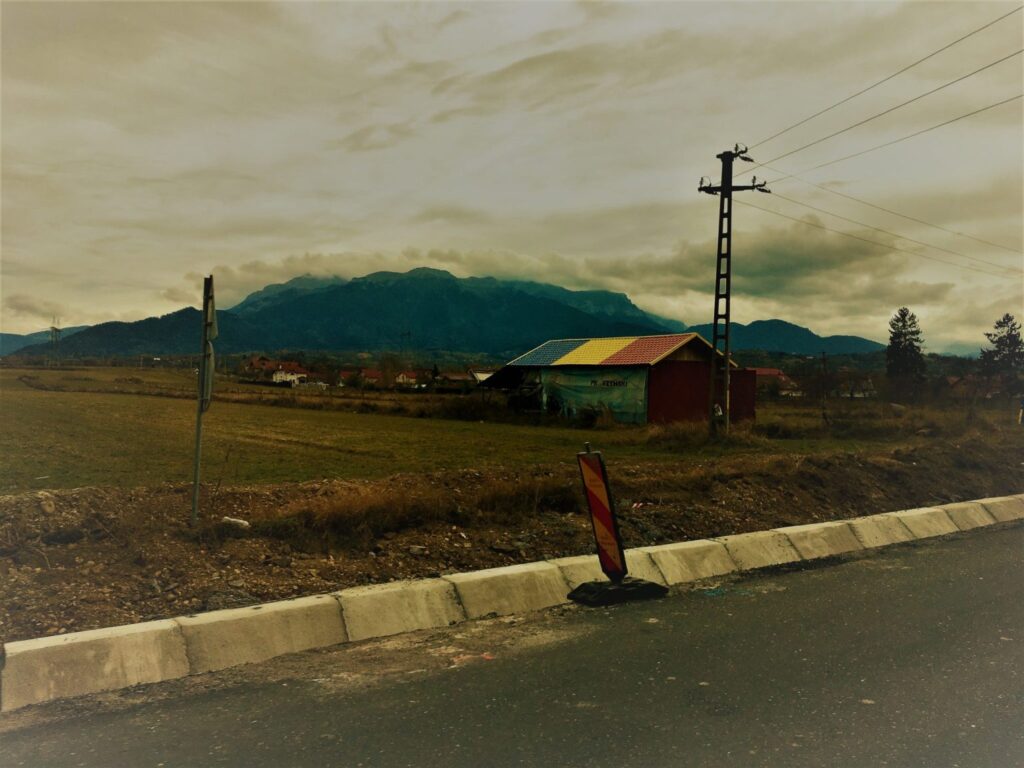
Bran Castle
We arrived in the town of Bran at around 13:00. The weather had changed from the one we had left at Brașov. Not sure if it was due to Dracula’s aura, but the sunny morning turned into a cloudy and windy one. Like back at Peleș Castle, there was a man waiting on the street to let us know where to park our vehicle. And also to make sure we paid for the parking spot lol. After leaving the van, we didn’t have to think too much to find out the way to Bran Castle. We just needed to follow the stream of people.
There were plenty of souvenir shops and food stalls all around the path that led to Dracula’s “house”. We didn’t have to walk much to start distinguishing the outline of Bran Castle. From the distance, it looked like this:
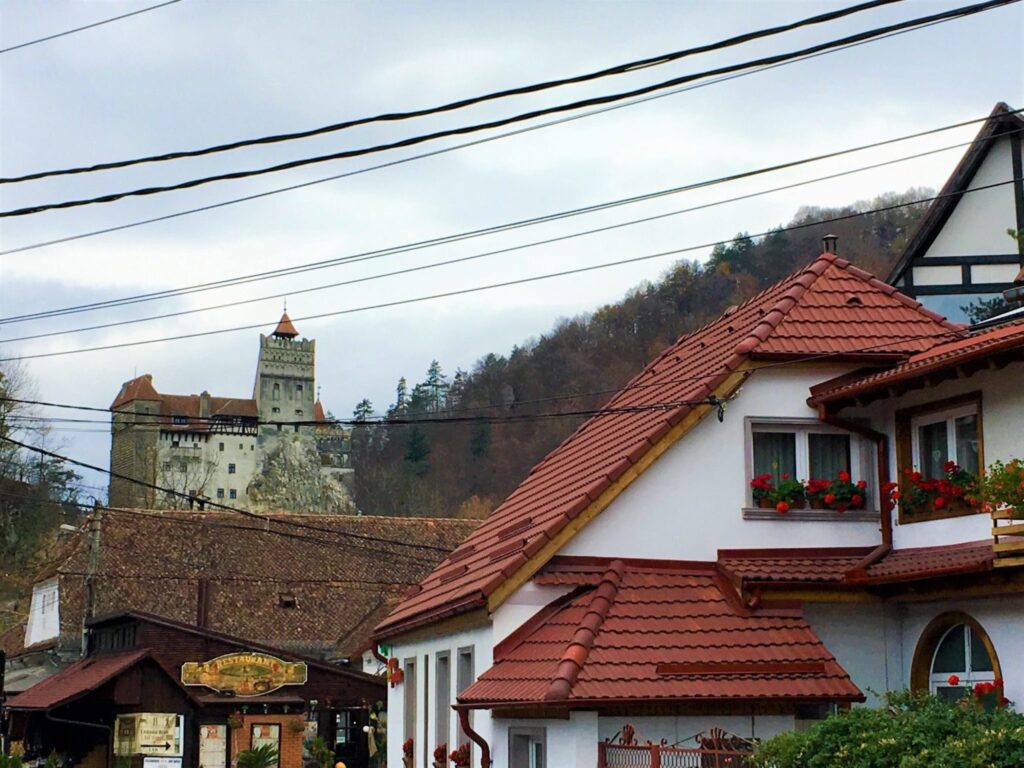
Can you see the tower on the right side of the castle? Then, if you look to the left, you will see some sort of a “darker” wall which marks the end of the building. This image was taken from far away. We can appreciate the whole castle and it looks like a nice one, doesn’t it? Well, try to capture this image and remember it well because, when I show you how Bran Castle looked from closer, you might think I’m teasing you. We thought the same when we were on the steep path that led to the castle. It seemed that, in the blink of an eye, the castle had completely changed.
About Bran Castle
The first documented mentioning of Bran Castle is the act issued by Louis I of Hungary on 19 November 1377, giving the Saxons of Kronstadt (modern Brașov) the privilege to build the stone castle on their own expense and labour force. In 1388, the castle’s construction was complete. The Castle was built on a steep cliff with an exceptional view of the nearby hills. It served the role of customs – holding 3% of goods transferring in and out of Transylvania – and the role of a fortress – the castle stood at the Eastern border of Transylvania and was used in an attempt to stop the Ottoman Empire’s expansion.
With the 1920 Treaty of Trianon, Hungary lost Transylvania, and the castle became a royal residence within the Kingdom of Romania. It became the favourite home and retreat of Queen Marie, who restored it and arranged it to be used as a residence for the royal family. The castle was inherited by her daughter Princess Ileana, who ran a hospital there in World War II. It was later seized by the communist regime with the expulsion of the royal family in 1948. The communist authorities would later on transform the castle into a museum.
On 18 May 2009, administration of Bran Castle was transferred from the government to Archduke Dominic and his sisters, Baroness Maria Magdalena of Holzhausen and Elisabeth Sandhofer. On 1 June 2009, the Habsburgs opened the refurbished castle to the public as the first private museum in the country. It is after this date that we can visit the famous Bran Castle.
Was Bran Castle Dracula’s home?
Bram Stoker’s character, Dracula, was a Transylvanian Count with a castle located high on a rock with a flowing river below. This character is often confused with Vlad Tepes (Vlad the Impaler), sometimes known as Vlad Dracula, who was the ruler of Wallachia on and off from 1448 to 1476. Other than being colloquially known as the inspiration for Bram Stoker’s in the novel “Dracula”, Vlad III is known for committing brutal acts of war. He liked to terrify his enemies by showing what happened to those who opposed them. If he received the nickname of Vlad “the Impaler”, can you guess what was he doing to his enemies?
Bram Stoker never visited Romania. He depicted the imaginary Dracula’s castle based upon a description of Bran Castle that was available to him in turn-of-the-century Britain. As for Vlad Tepes, the ruler of Walachia, he does, indeed, has an association with Bran Castle. Vlad was involved in several campaigns to punish the German merchants of Brasov. Passage to Wallachia was through Bran, the closest gorge to Brasov, which connected with Targoviste, Vlad Tepes’ capital.
In the fall of 1462, after the army of the Hungarian king, Matei Corvin, captured Vlad Tepes nearby the fortress of Podul Dambovitei, near Rucar, it appears that Vlad was taken to Bran Castle and locked up there for two months. Some people claim this to be truth while some others affirm Vlad the Impaler never stepped in Bran Castle. What’s sure is that Bram Stoker and his Count Dracula have done a great job attracting people to Bran Castle 😉
Visiting Bran Castle
Bran Castle is open on Mondays from 12:00 to 18:00 from April to September and from 12:00 to 16:00 from October to March. From Tuesday to Sunday it is open from 09:00 to 18:00 from April to September and from 09:00 to 16:00 from October to March. The admission fee is 40 LEI (around 8.5 €) for adults. Remember what I told you before about how the castle drastically changed as we approached it? Well, look at this:
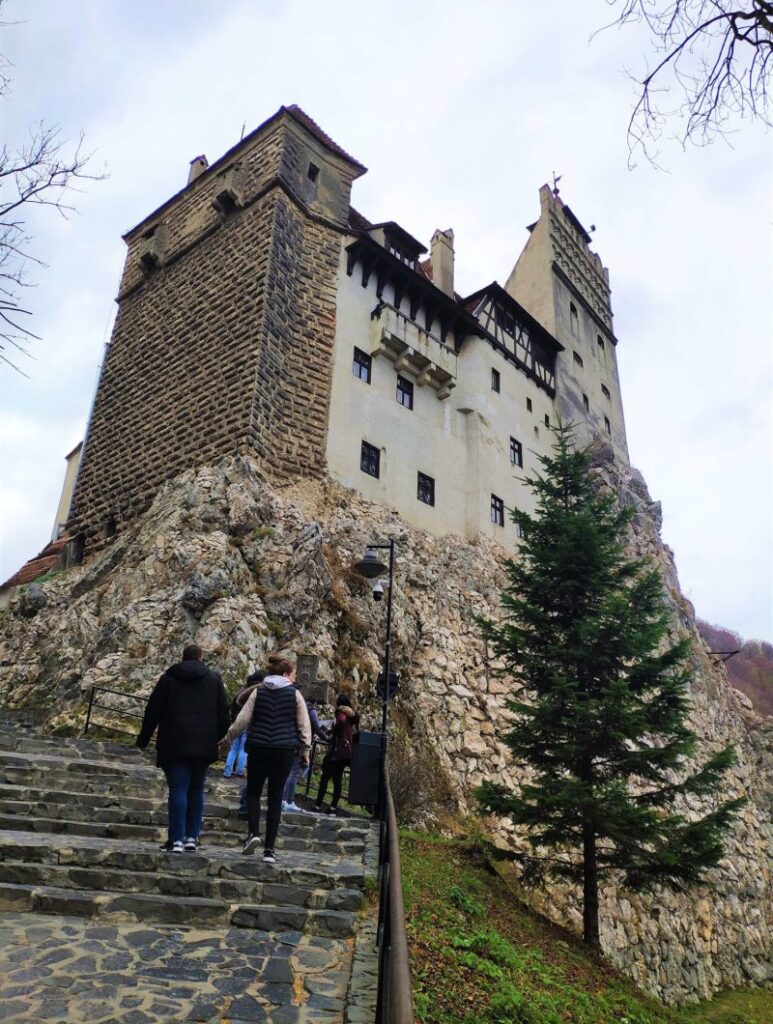
From close up we can see that, indeed, it stands on some sort of a cliff. But, it losses its beauty and greatness, doesn’t it? Thus, if you want to take a good picture from Bran Castle, do it before being too close to its entrance.
After paying the fee and entering Bran Castle, this was one of the first things we saw:
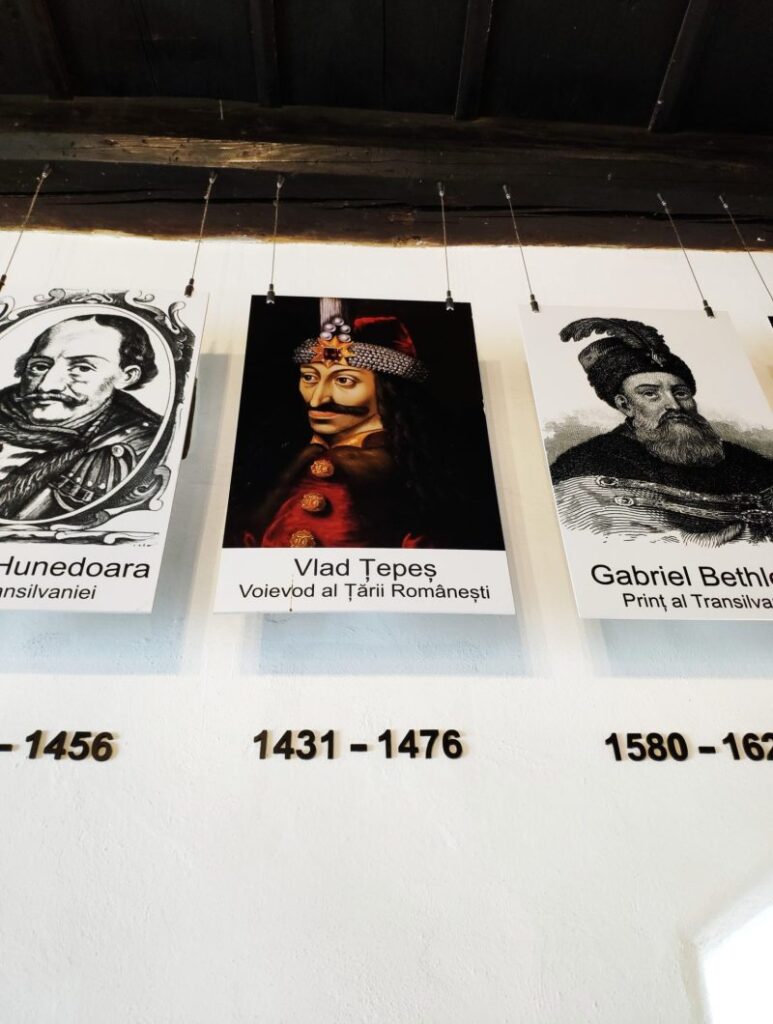
I guess they were all doing Movember back then… So, there you have it, the (in)famous Vlad Tepes, the one who (thanks to Bram Stoker) would then become Count Dracula. Does he look like someone who would enjoy impaling other people to you?
Throughout the visit to Bran Castle we saw some torture tools and some sort of depictions of what dinner and lunch would had been for Dracula. I guess it helped that just a few days ago Halloween had taken place and they were even using Bran Castle to host a Halloween party during the weekend. The tables and the “food” looked like this:
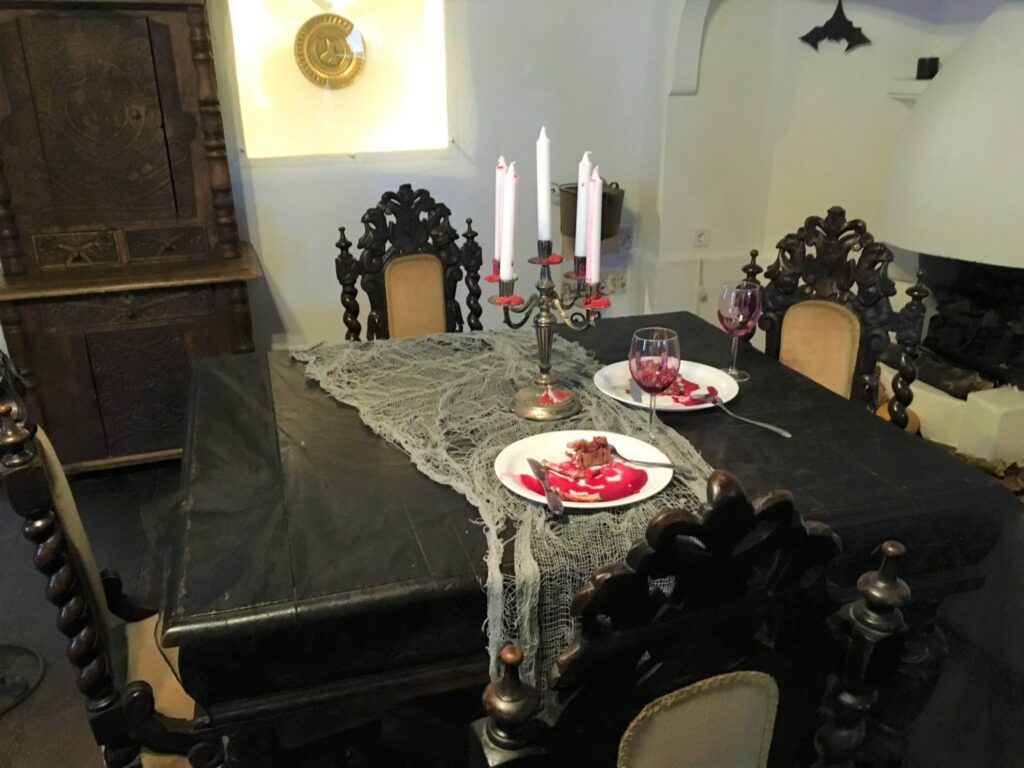
To be honest, we found Bran Castle kind of dull. There was not much to see. It was at a completely different level compared to Peleș Castle. There was a nice courtyard though from which we could appreciate the beautiful pine forest. The colours were really beautiful:
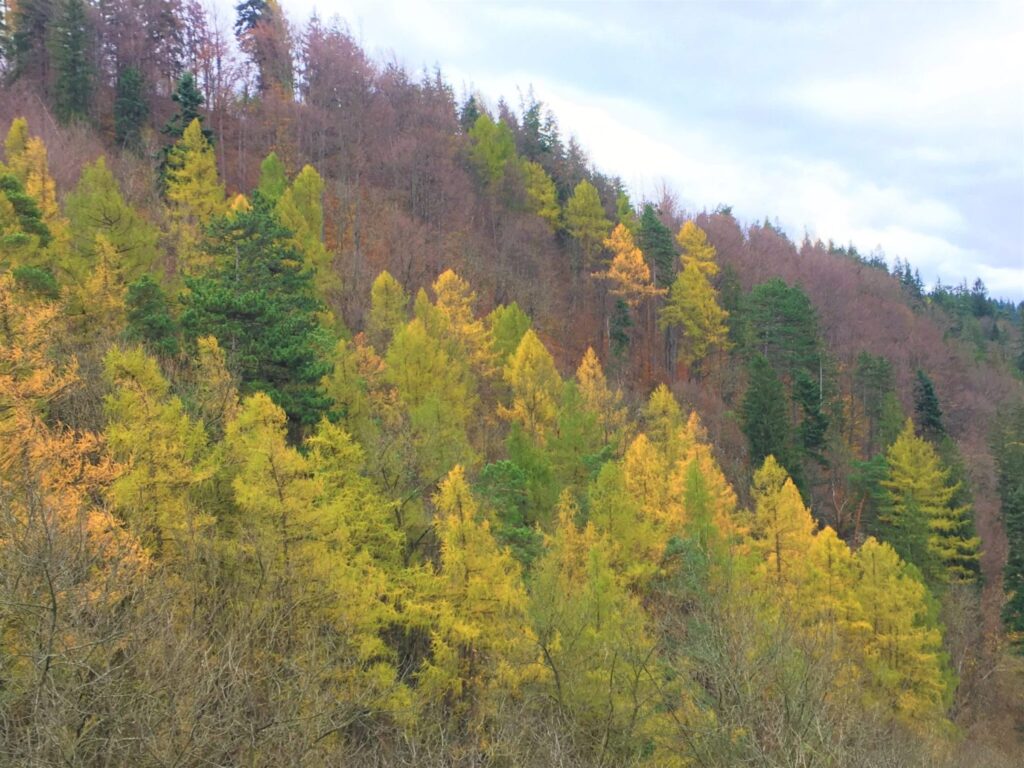
We didn’t spend a lot of time at Bran Castle. We went from room to room without taking our time because we didn’t find anything really interesting. Thus, after less than an hour, we left.

As we were looking for a place to eat, we agreed Bran Castle was more about the story behind the character of Bram Stoker. But, as a castle, we liked Peleș Castle much more. Thus, depending on how much time you have in Romania, it might not be worth it visiting Bran Castle since, according to our humble opinion, there are way worthier castles to visit.
Lunch at La Cristi
Up till that moment, when it came to looking for a place to eat, we had always realised on Tripadvisor and the list Nacho had written down. I told them I wanted to let the town surprise me for a change. Therefore, we walked around and decided to stay at “La Cristi”. We sat at a terrace they had outside and the setup was pretty cool. Everything from tables to chairs to stairs was made of beautiful wood.
We ordered some big beers to celebrate we had made it alive from Dracula’s Castle. As we were sitting outside, we saw quite a few trucks loaded with giant wood trunks. I guess that explained why everything was made out of wood at the restaurant: they had plenty of it all around. The menu had both local and international food.
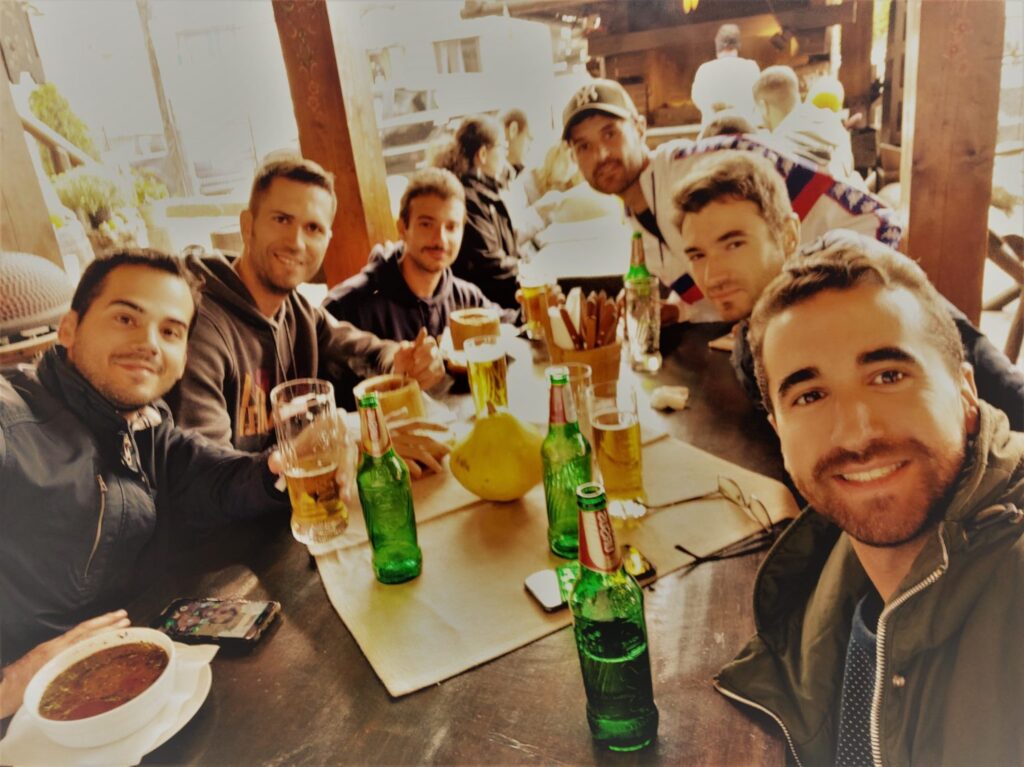
Pau and I ordered something “different”. It was basically a bean soup but, instead of in a regular bowl, in one made of bread. It wasn’t my first time trying something like that. You can find it in quite a few countries around the world. Nonetheless, just in case you have never seen it, there you go:
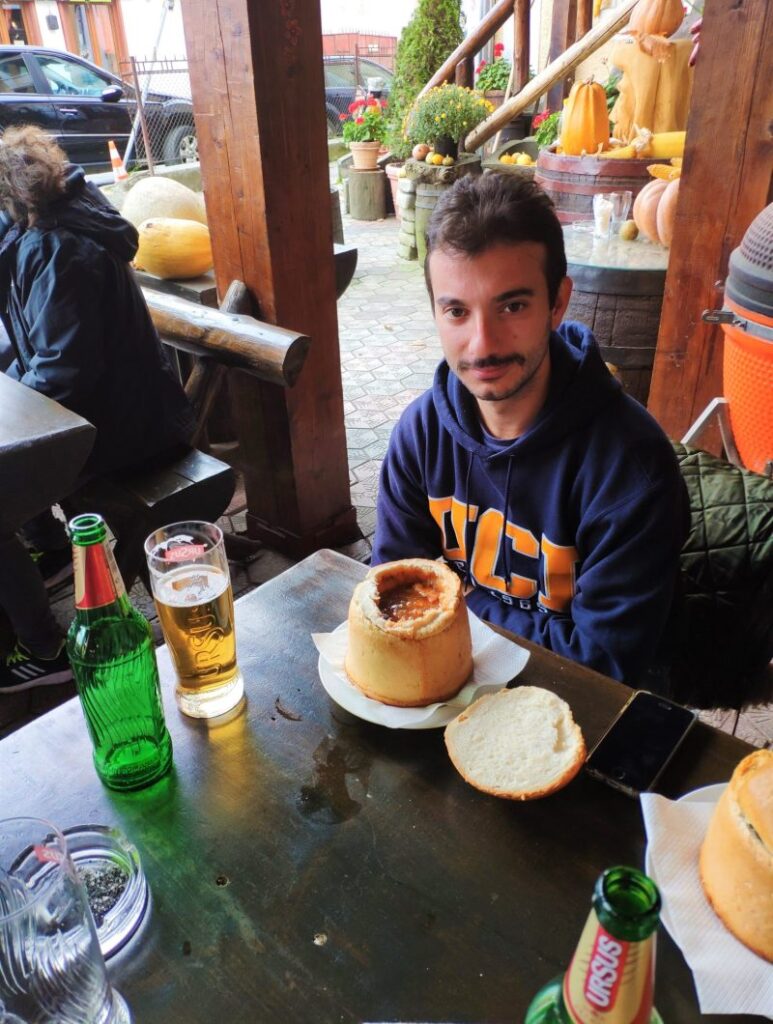
The food was good and prices were middle-high. Just in case you were wondering, La Cristi is kind of on the left-hand side from the main path that takes you to Bran Castle. If you are around, give it a try! 🙂
Rasnov Citadel
What’s with the name of this heading? Wasn’t the post about Bran Castle and Sibiu? Well, yes. But since we had to pass very close to Rasnov Citadel on our way from Bran Castle to Sibiu, we decided to stop at such a historical monument.

About Rasnov Citadel
Rasnov Fortress is located on a rocky hilltop in the Carpathian Mountains, above the town of Rasnov. It was built as a defense system for Transylvanian villages against Tartar and Turkish hordes during the 13th and 14th centuries, and it is considered to be one of the most well preserved “Rural Citadels” in Romania. Strategically located on the commercial route linking the provinces of Transylvania and Walachia, Rasnov differs from other Saxon fortresses in that it was designed as a place of refuge over extended periods of time. As such, it had at least 30 houses, a school, a chapel and other buildings more commonly associated with a village.
The defensive system included nine towers, two bastions and a drawbridge. The fortress was obliged to surrender only once in the year 1612. The invaders managed to find the secret route that supplied the people inside the fortress with water. With the location of their water supply no longer a secret, the need for a well inside the fortress became a must. To that extend, they put two Turkish prisoners to the task of digging a well through solid rock in the centre of the fortress. They were promised their freedom once the well was finished.
Work on the 470-foot-deep well began in 1623 and took 17 years to complete. The well provided extra security as it meant the people didn’t have to go outside the gates at all during a siege. It was in use until 1850 when the wheel broke. As it happened with other historical landmarks in Romania, it was damaged by fire and earthquakes and it underwent several restorations. As of today, Rasnov Citadel has its doors open for tourists looking for an enjoyable trip in the beautiful countryside of Brasov.
Visiting Rasnov Citadel
Rasnov Citadel is open daily from 09:00 to 19:00 and the admission fee is 12 LEI (2.5 €) for adults. This time we parked our van without anyone charging us for it. There were a couple of stalls selling food and drinks and also a train that could take you all the way up to the entrance of the Citadel. We felt like we could still use our legs so we went walking.
The walk took around 15 minutes or so and, on the way, we saw a dinosaur theme-park. It was kind of weird to see it there but then we saw a panel showing the European Union had granted Romania with a lot of money to build that park. I guess they thought it was the best thing they could build next to the Citadel? Nonetheless, if you are going with kids, it could be a good idea to check it out 🙂
After paying the entrance and passing through a gate, we saw the real deal. We quickly understood why, during centuries, it was obliged to surrender just once. What do you think?

We walked upward through the slope and we entered Rasnov Citadel. It was a peculiar feeling being there. Just thinking how many stories and experiences people lived inside those walls. Crazy, isn’t? We didn’t find the inside of the Citadel super well preserved, but we could kind of imagine what there was there before. Walking up to the centre of the Citadel looked like this:
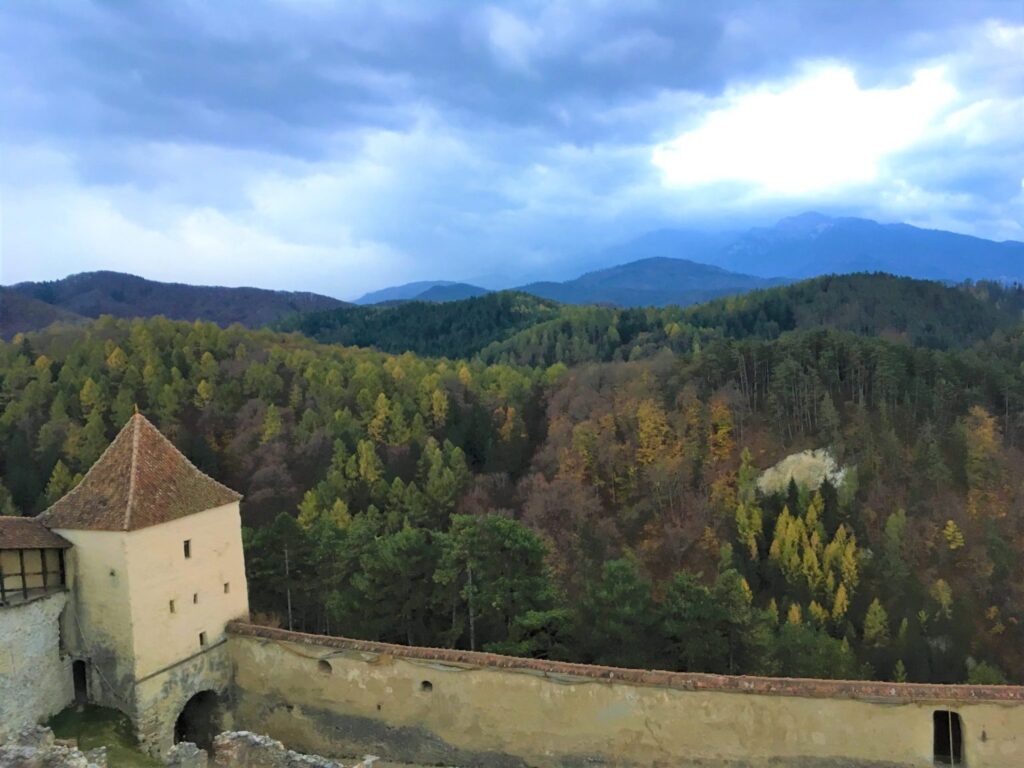
Once we were in the middle of the Citadel, we found another path that took us upwards. After reaching the summit, we arrived to my favourite part of Rasnov Citadel. It was some sort of a viewpoint from where we could “see it all”. We saw the Carpathians and its beautiful pine forests, the villages around Rasnov Citadel and the walls and towers of the fortress. It looked like this:

We spent sometime there, enjoying the views. After all, it had been a good idea stopping at Rasnov Citadel. If you are going to be around Brasov or on the way from Bran Castle to Sibiu, don’t hesitate and check it out!
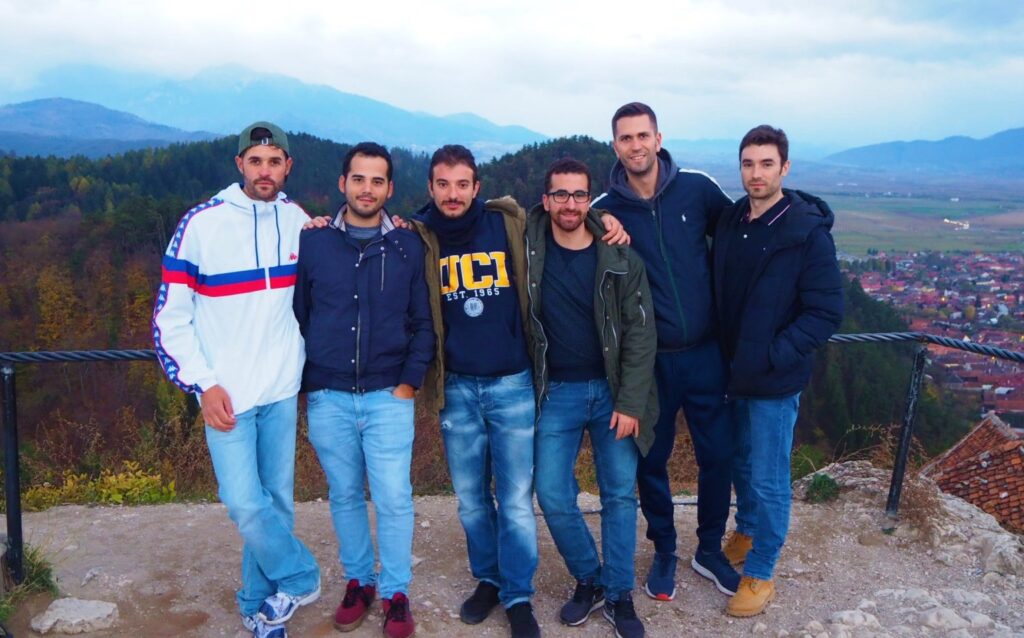
On the way to Sibiu
We left Rasnov Citadel behind and started driving to our next and final stop of the day: Sibiu. As you might remember from previous posts, I mentioned that the road from Bucharest to Peleș Castle was surprisingly good. Kilometres and kilometres on the motorway made our driving nice and easy. That, unfortunately, seemed like something far away in the past. The good all days were gone and so, we had to face 2.5 hours of national roads, “racing” against the crazy Romanian and, on top of that, it was raining cats and dogs. The last one was the cherry on the cake of our drive from Rasnov Citadel to Sibiu.
About Sibiu
Sibiu was the largest and wealthiest of the seven walled citadels. It was built in the 12th century by German settlers known as Transylvanian Saxons. With the riches obtained from their guilds, they could afford the construction of impressive buildings and the fortifications required to protect them. In 1699, after the Ottomans withdrew to his base of power in Hungary and Transylvania, the town became capital of Principality of Transylvania.
As of today, with a population of 400000 inhabitants, Sibiu’s Old Town retains the grandeur of its earlier days when rich and powerful guilds dominated regional trade. Like Sighisoara and Brașov, it has a distinctly Germanic feeling. Sections of the medieval wall still guard the historic area, where narrow streets pass steep-roofed 17th century buildings.
Sibiu is a pedestrian-friendly city with two easily accessible levels: the Upper Town, home to most of Sibiu’s historic sights, and the Lower Town, lined with colorful houses bounded by imposing city walls and defense towers overlooking the river Cibin.
Sibiu
By the time we made it to Sibiu the night had already fallen. Paco brought us to Sibiu safe and sound, regardless of the pour down. We had done some research on where to park for free in Sibiu, just as we had done for Brașov. This time, the streets were “Targul Vinului” and “Targul Pestelui”. We drove around them for a while until we found a nice spot for our faithful van. From there, we walked to our hostel.
Where to stay in Sibiu?
As we had been doing throughout the trip, once again, we relied on Nacho. This time he had booked B13 Hostel and it turned out to be a pretty good decision. The hostel had a great location. It was really close to “Piata Mare”, one of the main landmarks in Sibiu. From the moment we entered it, we realised it was pretty big, with plenty of space. The room was just like the rest of the hostel, with a lot of space, clean and with comfortable beds. I really liked the showers, there were 4 of them, making it perfect for a big group. Like that, we didn’t have to wait a lot before being ready to go out. And, finally, the price was also pretty good: 10 Euros per night (with no breakfast included). In a nutshell, if you are travelling to Sibiu, give it a try!
Dinner at Czech It Out
After taking a shower and getting ready, we left B13 Hostel and let Nacho led the way. Like in Bucharest and Brașov, he had done some research on places to have lunch and dinner. He had looked them all up in Tripadvisor. I’m not against it or anything like that. I think Tripadvisor as a concept is a great idea but, when you think about it, most of the places that show up there are tourist places. So, if you want to have lunch/dinner at more local places, you either need to go with a local or wander around until you find one.
All in all, we made it to this brewery-looking place at around 21:00. The place was in the middle of a parking lot. There were some sort of food stalls next to it, but they were already closed. From the moment we stepped in we could appreciate a cool setup, which would be then reflected in the food and prices. The menu was the fanciest we had seen so far during our trip. It reminded me to the “new-cuisine” places which have become trendy lately. We ordered trout, pumpkin soup and grilled vegetables. They were all presented in a sublime way and the food was delicious. Yet, after finishing with the meal, I felt as hungry as before entering the restaurant lol.
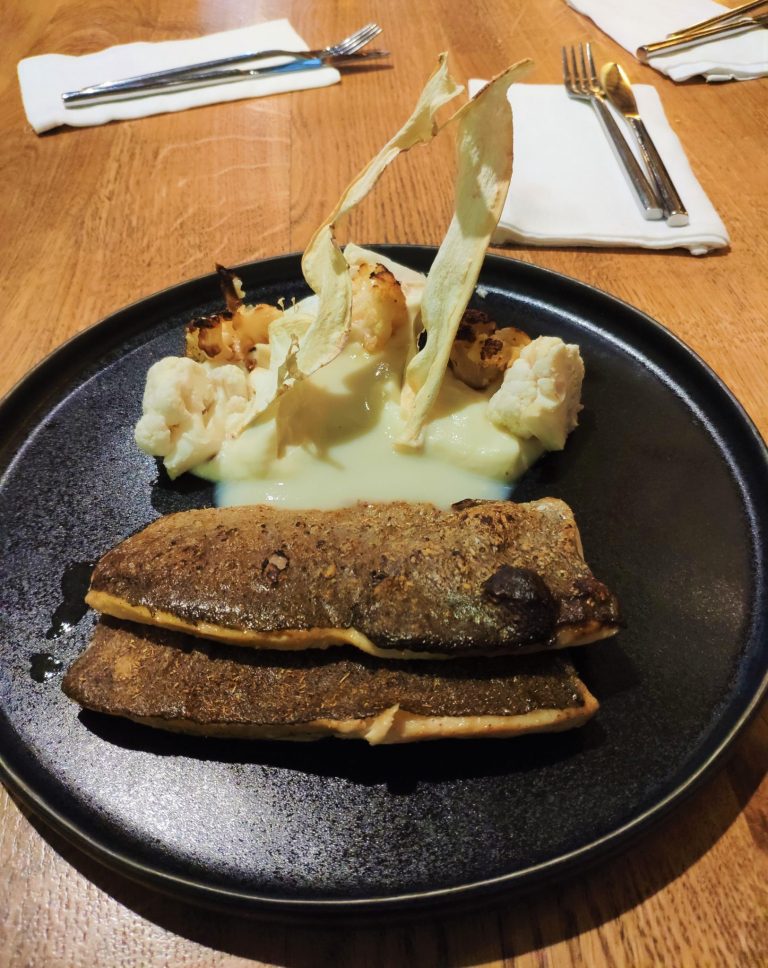
After dinner, we were still hungry, but prices were kind of high. Thus, we ordered a drink instead. And that was my favourite part of Czech It Out because… I discovered the amazing “Moscow Mule” cocktail! I ordered it mostly because of the name, to be honest. But this refreshing cocktail made of vodka, lime and ginger-beer, and served in a cooper mug, became one of the discoveries of the trip! It was really good! So, to wrap up, if you want to try some good food and cocktails, go “Czech It Out” (I love the play on words lol). But, if you are super hungry and you are not rich, then, try something else 😉
Monday night in Sibiu
We left the place and started to walk back to Sibiu Down Town looking for a bar/pub/club. It was Monday night and I know what you might be thinking but, in Barcelona, Nasty Monday is a good night so, why couldn’t it be the same in Sibiu? Well… It wasn’t. You see, Nacho was the one in charge of restaurants and hostels and I was the one in charge of partying venues. Therefore, according to my party-list, we had a few choices:
- Music Pub: live music. Open from 08:00 to 03:00. Piata Mica 23.
- Ursus Cotton Pub: a little bit of everything. Open till 06:00. Doctor Ion Ratiu 9.
- Imperium Pub: live music. Open till 02:00. Nicolae Balcescu 24.
That’s what I had on my list. The opening times were for a Monday night, according to several websites I checked. We started with Ursus Cotton Pub, because it was the closest from Czech It Out. We found it closed. After that, we made it to Imperium Pub, which was on the street next to our hostel. Can anyone guess what happened next? Bingo! It was closed! So, we bet it all in to Music Pub and… it was open! And not just that, it was a huge venue, with nice music but… with no one there except us lol.
Thus, we ordered some drinks and some food (damn you Czech It Out) and, 30 minutes later, we were told they were closing lol. They advised us to go “Geea Cofee”. They said it was the only place open at that time. We walked there and… it was open but they told us they were closing. Damn! So, after exhausting our options, we accepted our defeat and walk back to B13 Hostel. Thereby, the moral of the story is: if you want to party in Sibiu on a Monday night, start early 🙂
Tuesday morning in Sibiu
Since we didn’t have breakfast included in the hostel, after picking our stuff, we left. We walked to the place where we parked the van, left all the stuff and got ready for some sightseeing in Sibiu on a Tuesday morning. Our itinerary looked like this:
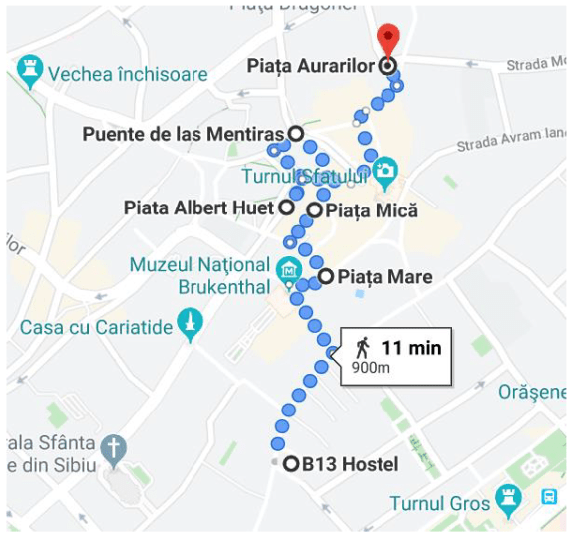
Piata Aurarilor
According to my research, Piata Aurarilor was supposed to be a “square with medieval houses”. Truth is, we found a pretty tinny square with nothing truly remarkable. For many years, this square was the main point of passage between the Lower Town and Piata Mica, the two connected by a 15th century stairway. We saw the stairway both when we arrived at the city and went to our hostel and now, after we had left the luggage in the van. Other than the stairway, I wouldn’t tag this square as a must-see in Sibiu.
Piata Mica
Piata Mica was something else. I mean, the square itself wasn’t impressive, but the views from there were pretty nice. We could see the famous “Bridge of Lies”, the “Luxembourg House” and the clock tower of the “Lutheran Cathedral”. The square was home to the town’s most prestigious master craftsmen, who lived in rows of arcaded houses along the north and east sides. Today, small shops, cafes, businesses and museums line the square.


The Bridge of Lies
After strolling around Piata Mica for a bit, we walked up to the first wrought iron bridge in Romania. The Bridge of Lies was built by Fredericus Hutte in 1859. Other than holding the milestone for being the first iron bridge, it is also known for its nickname. Some people say the nickname comes from the tricky (and liars) merchants who met there. Other say it has more to do with the passionate but transitory vows of love from the lovers who met there. What do you think? I think the arches above it fit well with the lamps and the clock tower of the Lutheran Cathedral 🙂
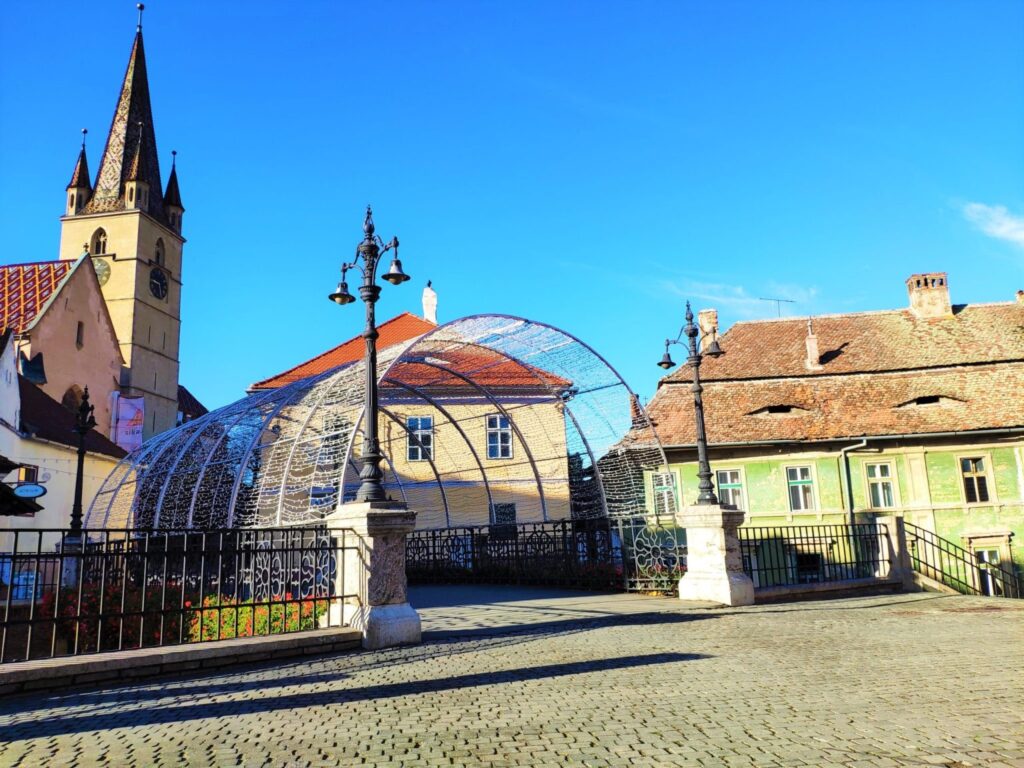
The Lutheran Cathedral
After passing over the Bridge of Lies, we arrived at Sibiu’s Lutheran Cathedral. It was built in the 14th century on the location of another 12th-century church. For three centuries it served as a burial place for the mayors, earls and other personalities from Sibiu. In 1671 a Slovakian craftsman built an organ to replace the previous one that was built in 1585.
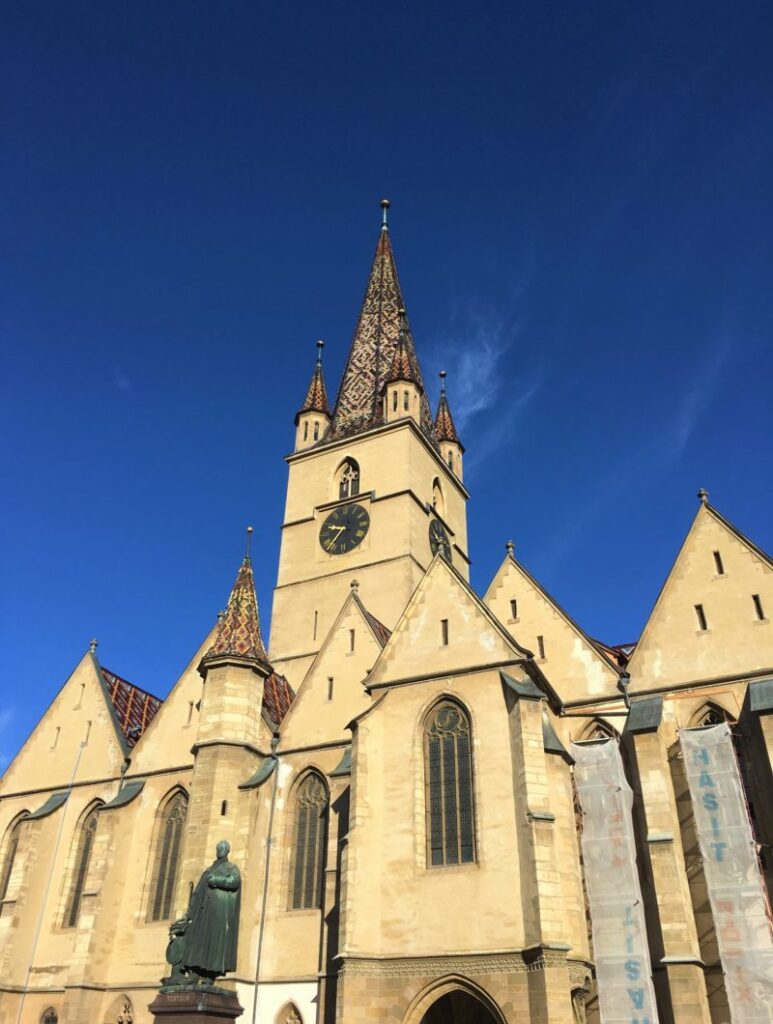
As of today, the newer organ is the largest in the south-eastern region of Europe. During the summer there are concerts every Wednesday night. It must be nice to listen to its music! Unfortunately the cathedral was undergoing some restorations and we couldn’t go inside. Nonetheless, we enjoyed its magnificence from outside.
Piata Albert Huet
The Lutheran Cathedral is at Piata Alberto Huet number 1. So, we were already there without even realising lol. As you can imagine, the cathedral is one of the key points on the square. But the third of the three main squares in Sibiu is home to other interesting stuff. It is the place where the earliest fortifications were built in the late 12th century. It also has some Gothic buildings with pretty vivid colours. They look like this:
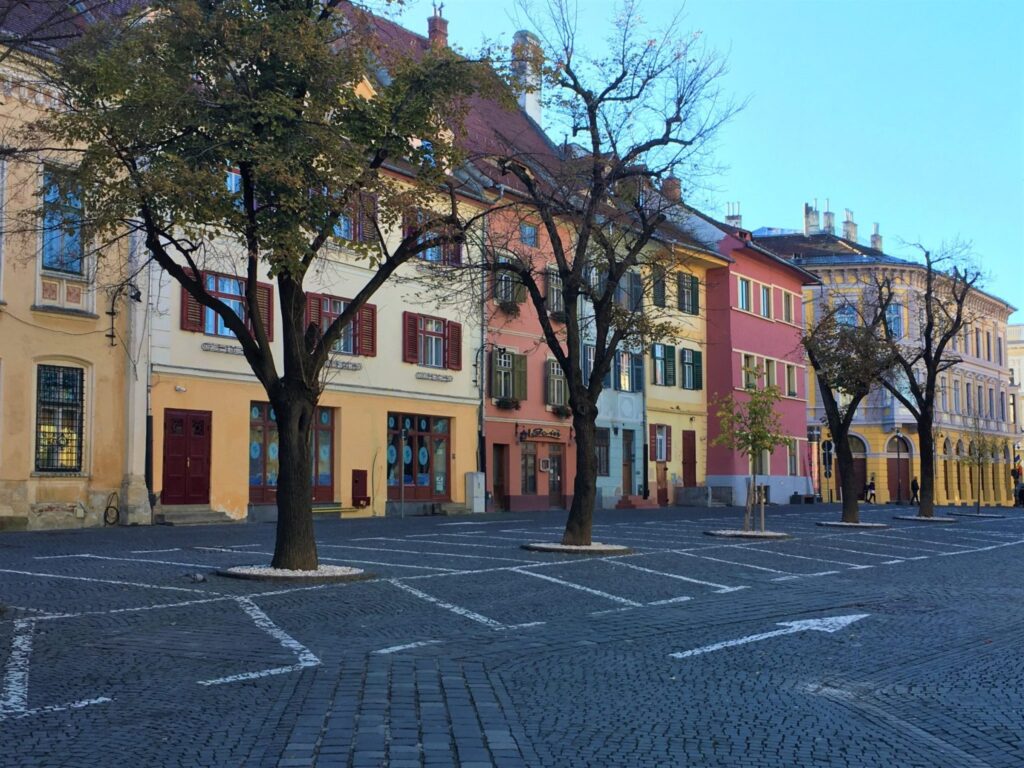
Piata Mare
We kept following our itinerary until we arrive to the largest square in Sibiu: Piata Mare. I really liked Piata Mare. It was pretty big and it had a lot of beautiful buildings around it. The only “problem” was that the city of Sibiu had already started to set up the Christmas stalls, meaning, they were kind of in the way plus they were not open yet. On this square we can find buildings as important as the “City Hall” and the “Brukenthal Palace” (one of the most important Baroque monuments in Romania). The cherry on the cake is one of the best viewpoints of the city, aka “Turnul Sfatului”.
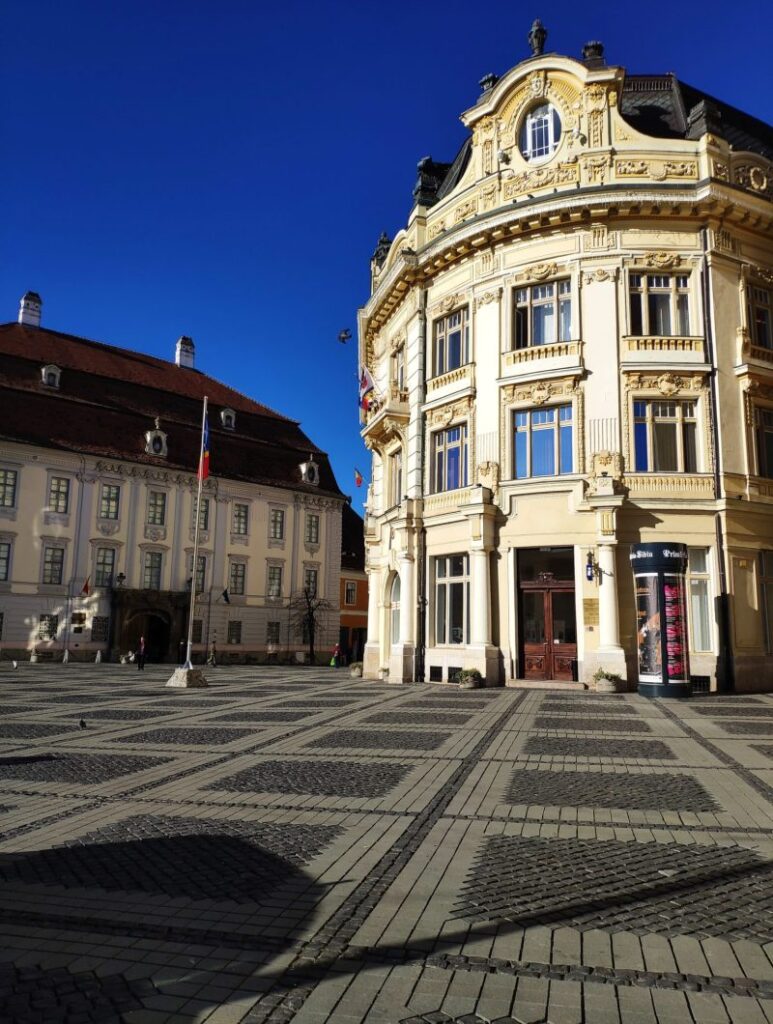
Turnul Sfatului
Turnul Sfatului (aka the Council Tower) was built in the 13-th century. It was used as an entrance gate to the second row of fortified walls built around Sibiu. Throughout the centuries, the Council Tower served as a grain storehouse, a fire watchtower, a temporary prison and even as a museum of botany. On the top floor, an observation deck allows a bird’s-eye view of the historic town and the Fagaras Mountains beyond.
The tower opens from 10:00 to 20:00 and the admission fee is 2 LEI (not even 0.50 €). We paid our entrance and started the way up through the narrow stairs. The tower was divided in different stories. Some of them had some paintings and other stuff, but nothing too impressive. Although there was one which I really liked. It depicted the city of Sibiu back in 1650, it looked like this:

The best of the tower was, as expected, the views from up there. The whole observation deck was surrounded by glass, nonetheless, we enjoyed some pretty awesome views. For example:
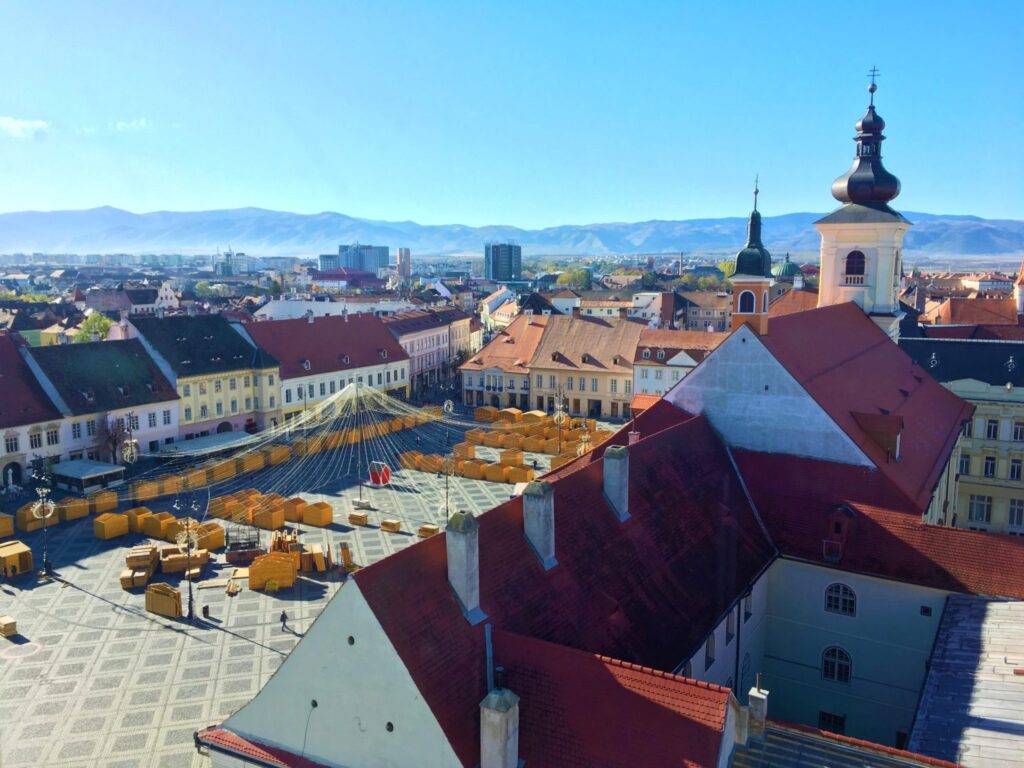
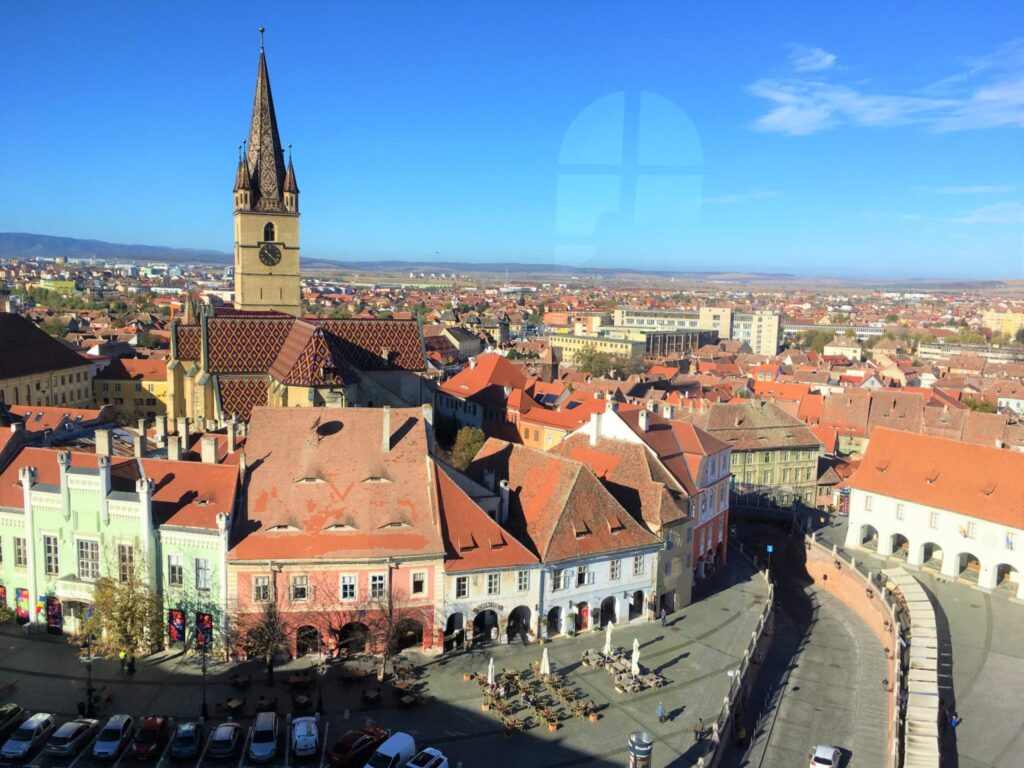
After a while enjoying such beautiful views, we started our way down and left Turnul Sfatului and Piata Mare behind.
The Holy Trinity Cathedral
The last stop of our sightseeing route in Sibiu was the Holy Trinity Cathedral. It was built in the style of a Byzantine basilica, inspired by Hagia Sophia (Istanbul) with the main spires influenced by Transylvanian church architecture and Baroque elements. Construction went from 1902 to 1906 on the site of a former Greek church. The second largest Orthodox cathedral in Romania was impressive and beautiful from the outside, but even more from the inside!

The interior, dominated by a massive gold chandelier, features neo-Byzantine decorations. Back in Bucharest, our tour guide Alina, told us that we should go on Tuesday evening to St Anthony church because there were plenty of girls praying to find love. Not sure if that was the case at the Holy Trinity Cathedral, but we saw quite a few youngsters. Compared to Spain, it seems the young generations are much more believers than us.
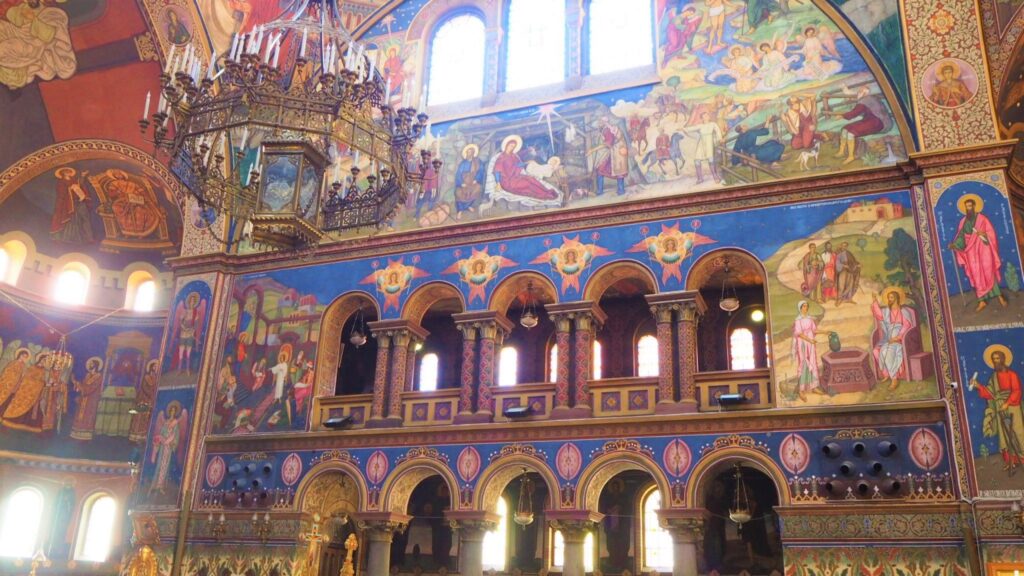
With the last glimpses of the Holy Trinity Cathedral we started to walk back to find our van. It was time for us to go and leave Sibiu behind. Where were we going next? I’ll give you a hint: it is known as the little Vienna of Romania 🙂 So, how did you like Bran Castle and Sibiu? Have you ever been there? Out of curiosity, did you go inside the Lutheran Cathedral or the Brukenthal Palace? How was it? Let me know in the comments below!




